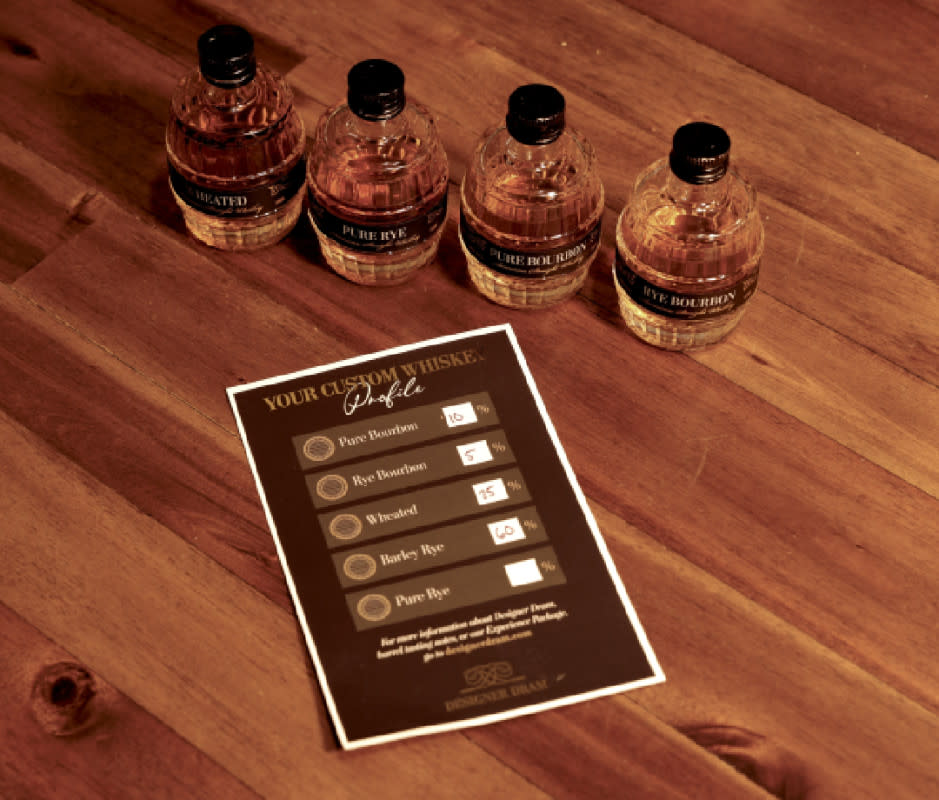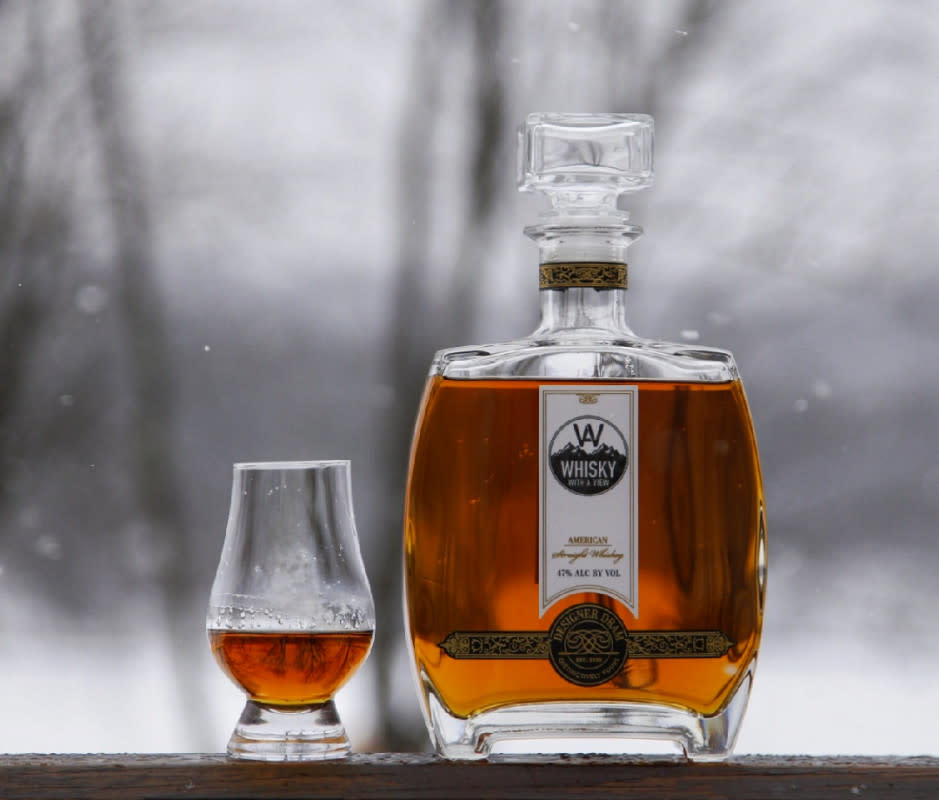Dream of Being a Master Blender? Designer Dram Lets You Make Your Own Custom Whiskey
Whiskey connoisseurs will go to almost any length to acquire rare whiskeys (think single-barrel bourbons and anything from Pappy Van Winkle) to boast about over a card game and one of the best cigars. Designer Dram has figured out a way to bake that desire for a special whiskey experience into their business model, letting you create your own one-of-a-kind bottle—blended and designed by you.
Blending is an art that, until recently, has not been fully valued in the U.S. the way it has in Scotland, Ireland, and Japan. At U.S. distilleries, the master distiller has historically been the top dog, but in the aforementioned countries, the master blender had primacy. That perception is shifting now in America, with the rise of sourced spirits and more blended bourbons.
Americans are coming to see blending as the art that it is, and with that comes a new trend of at-home blending kits—with Designer Dram leading the way with a unique whiskey experience.
Designer Dram: How It Works
The premise of Designer Dram is simple: Create your own blend of five base whiskeys in as little as 5 percent increments, design your label (within the company's font options and design parameters), and a week-and-a-half later, your own premium one-off whiskey arrives on your doorstep—signature required.
We tested out the whole process to see what it's like from start to finish.
The Blending Process

Stinson Carter
You can make the blend online, using sliders to select your percentages. But to me, blending whiskey virtually is like walking on the beach with your socks on. If you’re going to do this, there’s no use going halfway. For $90 more, you do the blending at home.
I opted for the at-home Experienced Package, where you’re sent a blending kit with a graduated cylinder, a tasting glass, and five different base whiskeys: pure rye, pure bourbon, barley rye, wheated, and rye bourbon. The included blending guide recommends that you pick your favorite and start with a base of at least 50 percent of that, then build from there. As a Scotch lover, I picked a base of 60 percent barley rye whiskey. I was surprised that my second favorite of the whiskeys was the wheated, which was the next highest percentage at 25 percent. Ten percent pure bourbon added a little sweetness, and then a final 5 percent of rye bourbon added a hint of spice. I wanted an easy sipper in flavor and on the palate, so I chose 43 percent ABV, but you can also choose to go for a higher 47 percent ABV. This higher percentage will bring out more heat and spice, particularly with a high rye blend, and will stand up well to dilution. For sipping neat, or with one large ice cube, I prefer the 43 percent ABV.
Related: 2024 Men’s Journal Travel Awards: Best Vacations, Hotels, and Luggage
The whiskeys come from MGP in Indiana, which supplies rye for whiskeys including Angel’s Envy, Bulleit Rye, and Templeton Rye, and bourbon for High West, Stellum, and Redemption. This is all to say that the juice is the real deal—you’re using the same base spirits that major respected brands use. While there’s no definitive age statement, Designer Dram says they are 5 to 10 years old.
The process of picking the blend was fun. The booklet they include helps walk you through what each base whiskey will bring to the party. What I found most interesting was the gap between what you think you will like based on the words, and what you actually like when you taste each one individually. Intellectually I never would have chosen wheated over rye, but it's what my palate wanted.
It’s fun to blend with someone, too. I went through the process with my wife, and it was interesting to compare and contrast our likes and dislikes. Now I’ll know in the future not to pour her a glass of rye whiskey, for example, and expect her to like it. To make a blend that suited us both, we had to find common ground: A touch of rye for me, a little extra pure bourbon for her.
Once you’ve committed to your blend and select it online based on your at-home tasting, Designer Dram says that their master blenders oversee the final blend. The analogy that came to mind was that they were essentially proofreading it. There were some minor adjustments to our blend versus what I chose online.
The Design Process

Stinson Carter
Making your own label and naming your whiskey is just as fun as blending it. I didn’t want a name that took itself too seriously, so I named mine "Dialogue Fodder" for two reasons: One, it will sit on my shelf facing me while I write, and two, I'll sip it if I’m trying to write dialogue with a little more gusto. Below the name, I added a quote from Cat on a Hot Tin Roof about sipping bourbon and waiting for the “click.” A couple of semi-pretentious literary references and I’m proud to have this bottle in a prominent place on my shelf.
The glass bottle is thick and heavy with a glass stopper, giving the aura of a decanter, so many will refill this and keep it as a keepsake after the original liquid is gone.
If you are an obsessive tinkerer, you will want more customization options that are on offer for the label. You can choose between a couple of design templates with different fonts, and you have control over all the words, but you can’t upload your own label. That said, it’s far and above the monogram laser etching options we’ve seen with major brands where you just get your barely visible name or initials scratched into the glass.
A day or two after making the label, I got an email that read: “Our designer has designed your label.” The PDF they sent was identical to what I had made online. Overall, I would prefer either more customization options for the label, or a greater sense that a designer had truly gone over it and made some changes. There are some empty white spaces on my label, for example, that a designer would typically fill by adjusting the font sizes for aesthetic balance. Not a big deal, but if you’re going to go all in on talk of the “designer,” then it would be nice to see their hand in it.
Related: This New Lexus May Be the Best Luxury Off-Roader Ever Made
What Happens When Your Whiskey Arrives?

Courtesy Image
I received the whiskey in 10 days, which felt pretty quick. It was well packaged, on par with a fine scotch, and the bottle is nicer than any typical whiskey bottle.
There was a sense of surprise when I opened it and tasted it for the first time. It was exactly as I’d imagined, the easy sipper I had set out to make. Nothing to blow any doors off a tasting, but something my wife and I could both sip on over a few rocks and enjoy.
Final Verdict: Is Designer Dram Worth It?
Designer Dram is definitely an intro course in blending. But, as someone who knows whiskey as a writer, appreciator, and ex-bartender, I still learned something in the process. What I like most about it, is that making a custom whiskey has been something reserved for an elite few who can afford to buy a barrel from a distillery and create their own bottle and label. Designer Dram makes that a lot more approachable.
As for approachability, it’s still $279 with shipping. Skipping the blending experience and just picking your percentages online is $189 with shipping. While this is affordable relative to going in on a barrel with your golfing buddies, it's expensive relative to fine whiskey at the liquor store. The biggest selling point is the emotional aspect of making something all your own.
Chintan Dhanji, Designer Dram’s founder, set out to offer people a chance to create a bottle with deeper meaning. He says that the biggest surprise to him, personally, is the emotional value that people attach to a bottle of whiskey that they have a hand in the making of.
“Customers send us videos, like the sheer emotion the father of the bride experienced when receiving his Designer Dram before walking his daughter down the aisle,” says Dhanji, “or the retirement party where the recipient vowed to hold the bottle as a keepsake, or the widow whose late husband's beloved Designer Dram went missing, and many more customers who keep their decanters long after their whiskey is finished.”
Why You Should Trust Me
I've been writing about bars, cocktails, and spirits for 16 years—and, before that, I bartended for more than a decade at Hollywood’s legendary Chateau Marmont Hotel. In one way or another, I’ve been employed in the realm of booze since the turn of the millennium.
Solve the daily Crossword

